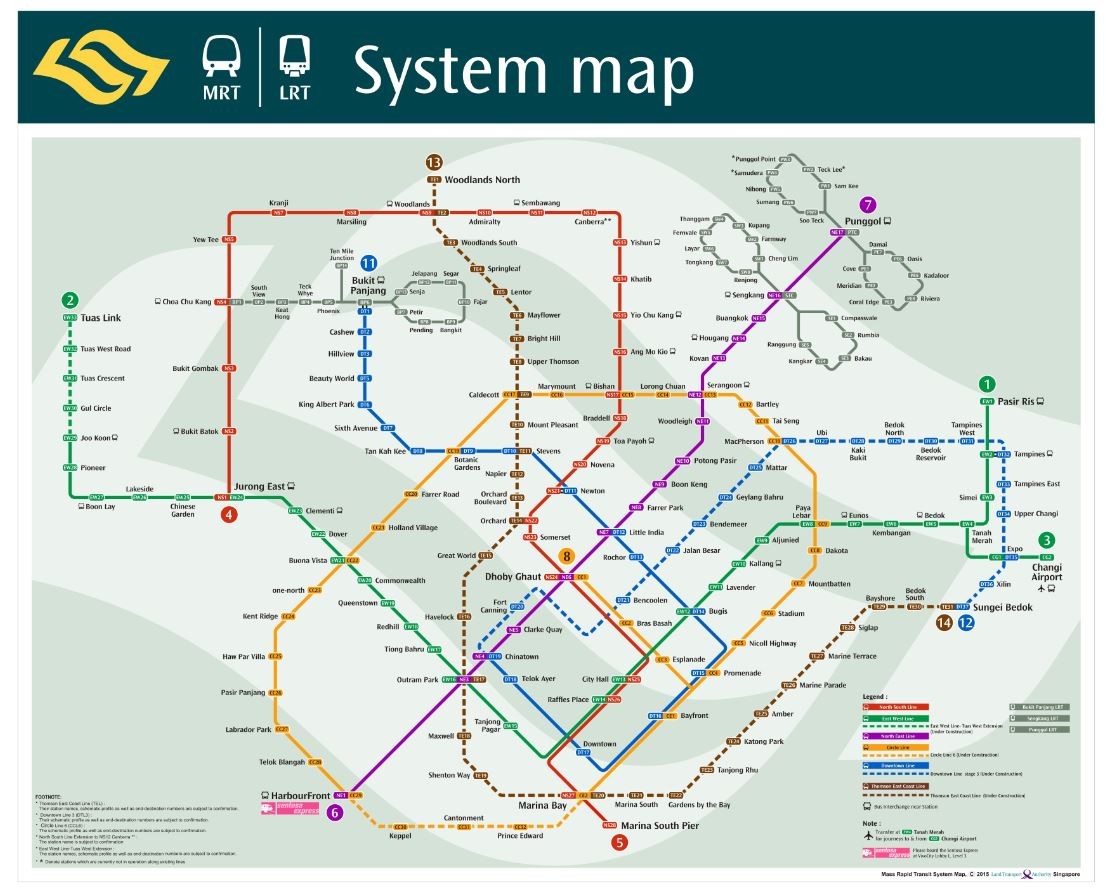Singapore’s desire to be a city in a garden is no better exemplified than the spectacular Gardens By The Bay. It can be difficult to know where to start, so here is our quick guide to the best way to make sure you don't miss anything.
The gardens are divided into Bay Central Garden, Bay East Garden and Bay South Garden. Supertree Grove, the super-size man-made trees, are in the south garden. They are covered in trellises and are home to over 300 types of plants. Best seen at night, you can also take the Skyway, an aerial walkway that lets you walk among the canopies of the smaller supertrees. There is a particularly stunning light show, Rainforest Orchestra, which takes place at 7.45pm and 8.45pm.
In the south garden, you can also find The Cloud Forest and The Flower Dome. These work alongside the supertrees, and aim to project the vision of sustainability. Visiting the Cloud Forest means that you will come face to face with the Cloud Waterfall, which are over 35 metres high. Following the path, you can also see the different plant life found at different sea levels. The climate here replicated is that of Southeast Asia and South America, whereas the Flower Dome is more Mediterranean, as well as featuring the drier climates of Australia and South Africa. There is also a spectacular orchid display here, as well as flower arrangements which change with the seasons.
From here, head to the Heritage Gardens. This is a look at the diversity in Singapore, with Indian, Chinese and Malay gardens. There is also a water play area in the Far East Organization Children’s Garden, perfect for the humid summer months.
Where to find food on your walk
There are some food outlets at the Supertree Grove, but these are definitely catered to tourists. If you want something more local, head away from the Marina Bay Sands Hotel. You will eventually find Satay By The Bay, a fantastic hawker center with almost every type of food on offer.
You can arrive at the Gardens by taking the Circle and Downtown Lines, the nearest MRT station being Bayfront. The park is open from 5am- 2am and admission is free. Opening times and admissions for the conservatories and other attractions may vary. You can visit the website for more information.
Have you visited the Gardens by the Bay yet? What is the best attraction to see? Comment below with your experiences!
Kampong Lorong Buangkok remains untouched by Singapore’s rapid expansion. Visiting this village shows just how much the city has changed over the last few years, and it can be seen as the last surviving link to Singapore’s past. Here is the story of the last kampong of Singapore. The land was first acquired by Sng Teow Hoon, a Chinese medicine seller, who rented out the land for people to build homes. The land later passed to his children, one of whom still lives there in the kampong to this day. The families that live there pay a small sum of S$30 in rent.
The kampong
Coming from the Malay, kampong etymologizes the English word ‘compound’, symbolizing a group of small houses that live together in close quarters to form a community. Singapore had plenty of kampongs until they were unilaterally destroyed to form high-rises to cope with the rising population. The survival of Lorong Buangkok really has been against the odds, even considering that it now rests on a swamp. The kampong as it stands today is home to 30 families, a mix of Malay and Chinese. Modern life has not infiltrated the community so much, amazingly. Families all know one another and take part in activities together, displaying the best example of ‘kampong spirit’ where people live together and survive together, without petty fallouts and consternation.
Visiting the kampong
There is not an awful lot here, so you can take your time to walk the streets. Rural life here has been beautifully preserved, and visitors can see plant life all around, encompassing shops, houses and even the local mosque. Take your time to walk around, but remember to be respectful. This is not a museum, and people still live here so be careful not to peer into too many windows. The houses are situated on dirt paths and are made of wood with zinc roofs that are distinctly weathered. There are no gates or barriers protecting the homes and if there are gates, they will usually be open. A rare sight indeed in Singapore. This is another representation of the kampong spirit that exemplifies this community. You will be greeted by dusty fake flowers, abandoned TV sets, ancient postal code signs and wooden clogs lined up outside the door. This perfectly exemplifies the olde worlde feel of the kampong. There are rumours that the kampong’s days are numbered much like the Bukit Brown cemetery in order to make way for new high-rises, so visit now whilst you still have the chance to appreciate a more rustic style of life.
How to get there
Take buses 70 or 103 from Serangoon MRT and ride 10 stops down the line to Church of St Vincent de Paul. Cross the road and walk towards the Shell petrol station. There is a flight of stairs next to the petrol station, which you need to walk down, cross the canal and walk straight. The kampong can be found on the left.
Have you visited the last remaining kampong in Singapore? Comment below with your experiences!
You might have lived in Singapore for a while and think that you know all there is to know about the city. You might assume that amidst the skyscrapers and luxe hotels, there isn’t a square metre that lies undiscovered. Maybe not, but there are parts of Singapore that do not have quite the same footfall as others. These secret corners have some tantalising delights for tourists, expats, and locals alike. Let’s take a closer look.
Colbar
This bar used to be a British Army hangout back in the 1950’s and it has retained some colonial charm. They sell plenty of beer (British nonetheless) and Hainanese Chinese cuisine, including a great Hainanese chicken rice. There are plenty of historical artefacts, and the owners have tried to keep as true to the original as possible. Look out for the antique weighing machines.
Coney Island
Much like it’s namesake in New York, Coney Island is quite popular among locals and tourists alike. There are also plenty of white beaches, that look as if they could be straight out of a Thai holiday brochure. Punggol Ranch is the entrance point, and it is worth looking at itself, for all the flora and fauna on display. Some plant species are even believed to be extinct throughout the rest of Singapore. You might even be lucky and catch some birds in migration.
Bollywood Veggies
This organic farm, run by Ivy Singh Lim, is out of the main drag of the city but is well worth the car trip. There is an excellent restaurant here, which really does farm to table exactly right. The restaurant is not the only gem here. There are also plenty of workshops, kids activities, cooking classes and tours of the grounds.
It’s no secret that travelling is so much easier when you have a car. However, the costs that come with owning a car sometimes far outweighs its benefits, especially when you’re living in Singapore. For example, according to Big Fat Purse, you need to be earning, at least SGD 5k a month in order to maintain ownership of your car, due to the rising costs of petrol. Car owners must also obtain a Certificate of Entitlement (COE) before they can drive their vehicle in Singapore, and costs more than SGD 80k to bid, due to the government’s decision to curb car ownership as part of efforts to reduce traffic volumes in urban areas.
So what happens if you can’t afford to buy a car? Of course, if you’re living near your workplace or in an accessible location like Orchard Road, you can easily walk or cycle to wherever it is you need to go. The cycling culture is very much alive and flourishing in the island city-state. There’s even a guide on intra-town cycling by Singapore Land Transport Authority, which covers everything from cycling etiquette to designated cycling paths. However, if cycling is not your thing…
Getting Around In Singapore
For first-time expats in Singapore who don’t have a car or aren’t keen on getting one, rest assured that getting around in the island city-state using public transport is not as difficult as it sounds. One can get almost anywhere in Singapore either by train, buses, cabs, and rented cars. Here’s how:
Bus in Singapore
If you’re looking for the cheapest way of getting around Singapore, look no further: Not only does Singapore’s bus system has an extensive network of routes, it’s also the most affordable method of transportation. Upon boarding, you can pay for your bus fare using cash (just make sure you have the exact change) or tap your EZ-Link stored-value card on the card reader. Then sit back and enjoy the scenic ride to your destination in air-conditioned comfort.
MRT/Train in Singapore
The fastest way to zip around the city is undoubtedly by the MRT. Almost all of Singapore’s key attractions are located within walking distance of an MRT station, and if they aren’t you can still supplement your travel by taking a bus at the stop outside the railway station to your final destination. In order to travel on the MRT, you would need to buy a ticket or use an EZ-Link stored-value card.
Mention the word "trailing spouse" to a stay-at-home expat husband or wife and it may ruffle a few feathers. The common protest remains: "Who's" following "who" across the world when the decision was made as a unit? "Trailing" seems to imply following your other half without much of a purpose beyond just, well, tagging along! Coined in 1981 by Wall Street Journal reporter Mary Bralove in an article titled “Problems of Two-Career Families Start Forcing Businesses to Adapt”, the term refers to an individual who follows their spouse or partner to relocate to another city, state, or country because of a work assignment, and the issues that arises as a result of that move.
While relocating to a foreign place can be exciting initially, when the dust settles, you’re left standing in a new condominium with boxes of belongings for your entire family to unpack; experiencing difficulties in adapting to a new culture where everyone eats noodles or dumplings for breakfast; as well as accepting that you’ve had to make sacrifices in the process, which makes the term “trailing spouse” rather rankling. It trivializes the issues you face and relegates you to the role of matrimonial baggage, because you’re doing so much more than just “trailing”.
Having been in those shoes ourselves, Team Expat thinks that there should be international awards for trailing spouses who have to put up with a lot, including:
The Unselfish Team Player - They give up their existing career or even future career goals during the relocation period to support their partner's dream. In any case, statistics show that the vast majority of spouses who were employed at home are unable to find employment abroad.
The Power International Adaptor - They have to adapt to new environments and culture, and in some cases, help their children adapt to their new surroundings as well, which means being strong for the entire family and putting up a brave front! All of this involves working hard at reestablishing a new identity, personally, and in professional and social circles.
Singapore has always been one of the more popular countries among expats, but did you know that the island city-state boasts the highest paid expats in the world? According to a recent article by HSBC, relocating to Singapore pays off lucratively for expats in terms of disposable income and savings. But that is only a few of the many reasons why expats who move to Singapore are the highest paid in the world—and Team Expat has collated and broke down the facts for you below:
Fact #1: Low cost of living and working in Singapore
Contrary to popular belief, the cost of living and working in Singapore can be kept to a minimum, if one knows how. For example, instead of owning a car, why not use public transport? Not only is the country’s public transportation network extremely accessible—you can go almost anywhere by bus or MRT (Mass Rapid Transit) alone—it’s also really cheap. If you need to go somewhere that’s not accessible by bus or train, the option for cabs is open to you, and they are still more affordable than the cost of maintaining a car.
The Strait Times reported that living and working costs in cities with more space has decreased, and Singapore recorded the biggest decline at 16.6 per cent. Although this can be seen as a decline in local economic conditions or demand for property, cheaper rents could also prove to be a global competitive advantage—low rents coupled with high quality of living could entice expats to move to the country. Ultimately, the low cost of living and working in Singapore makes it easier for expats to save more of their income, making them the highest paid in the world, based on the amount of disposable income leftover after taxes, household and necessary expenditures.
Fact #2: Singapore’s financial markets are flourishing
According to The Strait Times, more and more millionaires are choosing to relocate to Singapore over Hong Kong due to the Umbrella Movement—a pro-democracy demonstration that began on 28 September 2014 as a form of grass-roots objection to the decision of the Standing Committee of the National People's Congress (NPCSC) of 31 August 2014. Although it seems that activists have abandoned their fight, leaders of the pro-democracy movement explained that the struggle is not over, and that they are merely laying low until further developments in Beijing. As a result, wealthy expats from Hong Kong prefer to relocate to Singapore, which raises the average of 1 in 35 Singaporeans by 17 per cent, according to WealthInsight.
Additionally, Singapore is known for its superior quality of life and flourishing financial markets, which factors into migratory expats’ decision-making. An increase in the number of wealthy expats in the country leads to higher amounts of spending, which in turn helps to stimulate the economy more, if Keynesian economics are to be believed. Further reports from WealthInsight also show that the country’s wealthiest have the lowest average wealth in Asia (USD 5.2 million per individual)—a lower average means that the wealth is distributed evenly among the country’s population.
Think back to the day when you were packing for your big international move: Remember the stress of deciding what you should bring or leave behind? Due to limited luggage space and budget constraints (we can’t all hire movers to ship every piece of furniture we have to our new home), was there anything that you wished you packed but didn’t? How do you decide what you should bring along?
Packing to move abroad is a whole different ballgame from packing for a vacation. You’re going to be home away from home for an extended amount of time, and unless you have relatives to house-sit for you back in your home country, you’re likely going to sell it, along with most of the items you own. How you decide what to keep and what to sell requires you to do some research about the country you’re relocating to.
To help you along, Team Expat has compiled a list of items which, according to expats like yourself, they regretted not packing:
1. Converters and adapters
Unless your home country has the same electrical configuration as your new country of residence, you’ll need converters to change the voltage of the electricity to match your devices, and an adapter to allow your chargers to fit into the wall sockets. While converters and adapters are readily available in most countries, especially Singapore, it isn’t worth shelling out additional money for them if you already have them, plus you will definitely need them for the first few nights to charge your devices in case you don’t have time to run out and buy some.
2. Bedding
This is one thing that many expats tend to forget, since bed sheets and pillowcases can take up a lot of luggage space. However, unless you’re arriving early to a home furnished with a washer and dryer, or planning to sleep on a sheet-less bed, you may want to pack a couple of bedding sets. Doing this also ensures you don’t have to worry about doing laundry immediately when you land, but remember to check out the size of the beds in your new home.
Relocating to another country is daunting, however, Singapore is a welcoming city with easy access to modern amenities and facilities. The transition can be made easier if you take the time to get prepared well ahead of time.
Singapore to the uninitiated…
A tiny dot at the tip of the Malay Peninsula, Singapore is an economic giant – globally. The vibrant city is a melting pot of Malay, Chinese, Indian, Arabic, and English cultures, an ethnic mix reflected in its eclectic cuisine. Flourishing under the late Lee Kuan Yew’s efficient and determined government, this island nation is considered south east Asia’s most modern city excelling in trade and tourism. It’s safe, clean and green environment, warm tropical climate, and excellent infrastructure all combine to make Singapore a welcome change for millions of expats around the world.
Important To-Do’s Before You Move to Singapore.
The thought of change is exciting, but it’s also best described as the lull of anticipation before the storm! Once you get into the actual hustle and bustle of logistics and paperwork, “new” experiences don’t seem so hyped up anymore. To help alleviate some inevitable relocation anxiety, here’s a list of things you should prepare for:
Gather information
TheExpat.com is a great resource for expats moving to Singapore, and we are working hard to be truly comprehensive. Aside from our blog featuring the latest expat information, news and happenings around Singapore, check out our experts profile page for professional advice on relocating, property, finance and more; don’t forget to look at our classifieds section if you’re looking to buy and sell expat second hand items in Singapore; and our business directory will point you to tried and tested services.







